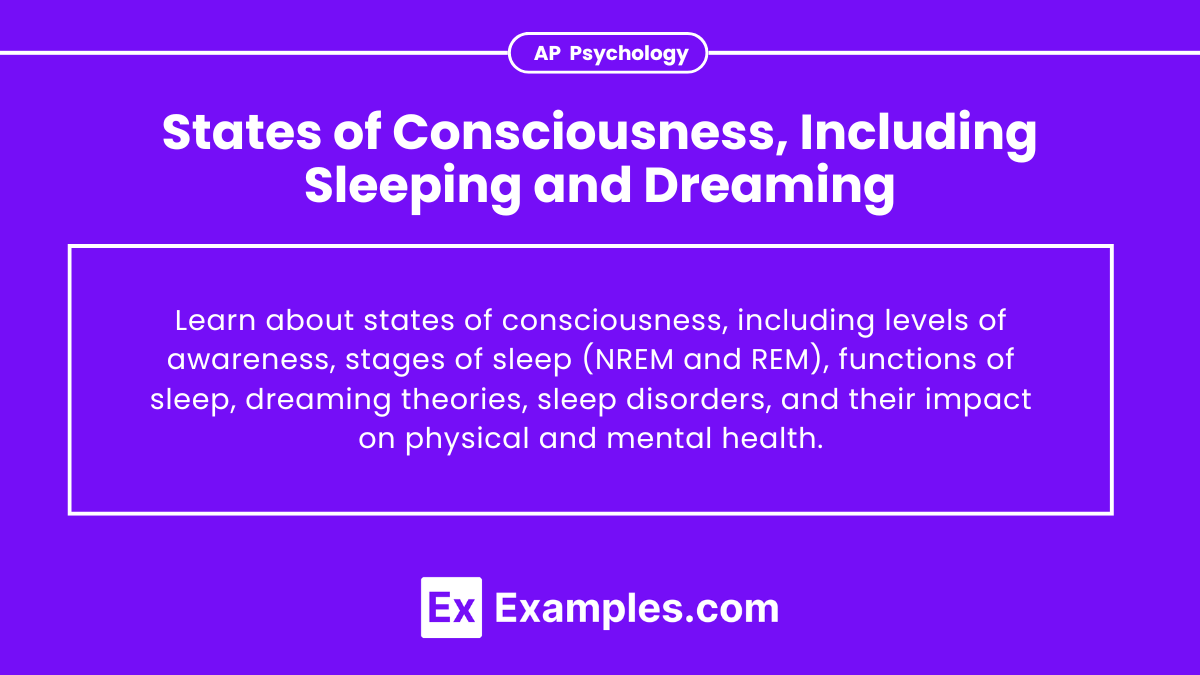Understanding states of consciousness, including sleeping and dreaming, is crucial in AP Psychology. Consciousness encompasses our awareness of ourselves and our environment, varying from wakefulness to altered states like hypnosis. Sleep, a vital altered state, involves NREM and REM stages, each with distinct characteristics and functions. Dreaming, primarily occurring during REM sleep, is explained by various theories. Recognizing these concepts helps in analyzing human behavior and mental processes, key topics in AP Psychology.
Learning Objectives
Understand the various states of consciousness, including the levels and types (e.g., waking, sleeping, altered states like hypnosis and meditation). Specifically, focus on the stages of sleep (NREM and REM), the sleep cycle, and the functions of sleep. You should also learn the major theories of dreaming (Freud’s psychoanalytic theory, activation-synthesis theory, and information processing theory) and recognize common sleep disorders and their impact on health. Grasping these concepts will help you analyze how consciousness and its alterations affect human behavior and mental processes.
Consciousness

Consciousness is the state of being aware of and able to think about one’s own existence, thoughts, and environment. It includes various levels, from full wakefulness to altered states like dreaming, and encompasses both active awareness and passive experiences. Consciousness is central to human cognition and behavior.
Levels of Consciousness
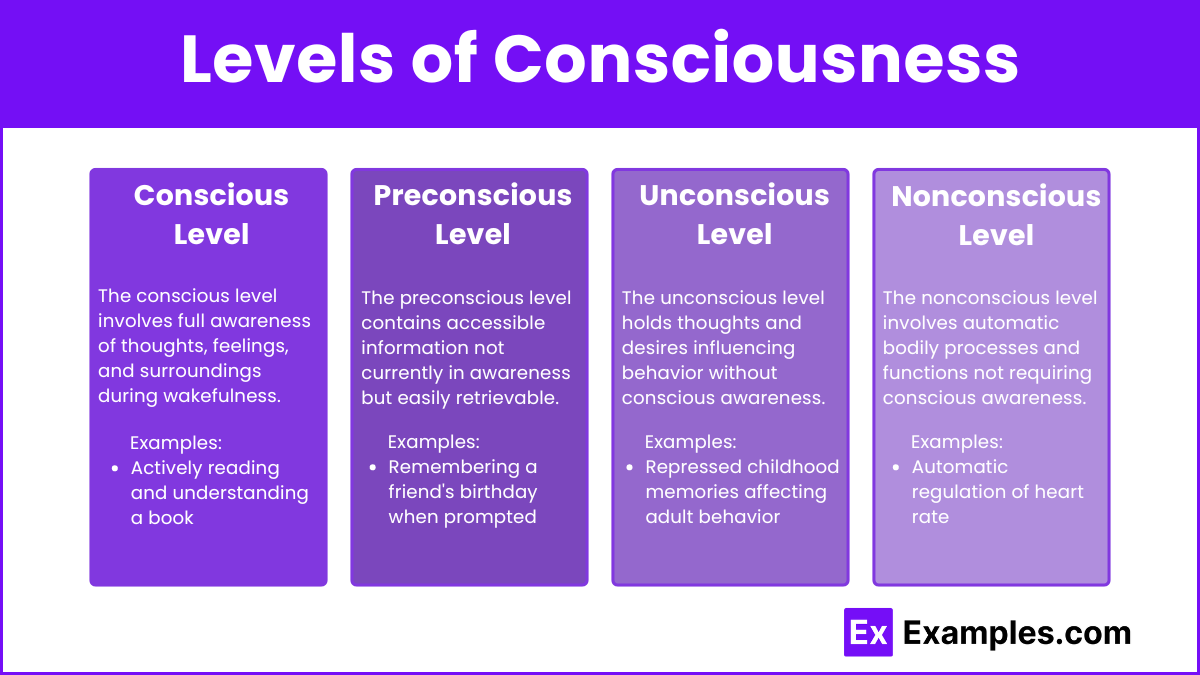
Consciousness can be divided into several levels, reflecting the depth and type of awareness:
1. Conscious Level
- Description: This is the state of full awareness where we are awake and aware of our thoughts and environment.
- Examples: Solving a math problem, engaging in conversation, or reading a book.
2. Preconscious Level
- Description: Contains information that is not currently in our conscious thought but can be easily brought to consciousness.
- Examples: Remembering a friend’s birthday when asked, recalling what you had for dinner last night.
3. Unconscious Level
- Description: Holds thoughts, memories, and desires that are not accessible to our conscious awareness but still influence our behavior and emotions.
- Examples: Repressed memories, underlying fears, and instincts.
4. Nonconscious Level
- Description: Involves processes that occur in the body and mind without conscious awareness.
- Examples: Breathing, digestion, regulation of blood pressure.
Altered States of Consciousness
Altered states of consciousness are variations from the normal waking state and can occur naturally or be induced by various methods.
Natural Altered States
- Sleep: A regular state of rest characterized by reduced physical activity and awareness.
- Dreaming: A mental state during sleep where vivid images, thoughts, and emotions occur.
- Daydreaming: A spontaneous shift of attention away from the present task to internal thoughts or fantasies.
Induced Altered States
- Hypnosis: A trance-like state induced by suggestion, characterized by increased focus and reduced peripheral awareness.
- Meditation: A practice of focused attention and mindfulness leading to a relaxed state of consciousness.
- Drug-Induced States: Changes in consciousness due to substances like alcohol, caffeine, or psychoactive drugs.
Characteristics of Altered States
- Perceptual Changes: Altered perception of time, space, and sensory input.
- Emotional Changes: Heightened or dampened emotions.
- Cognitive Changes: Changes in thought patterns, such as increased creativity or difficulty concentrating.
- Self-Control: Alterations in the sense of control over actions and thoughts.
Importance of Studying Consciousness
Understanding consciousness helps us comprehend how we perceive and interact with the world. It also provides insights into the human mind, including the nature of reality, self-awareness, and the mechanisms underlying mental health conditions.
Common Altered States
- Sleep
- Dreaming
- Hypnosis
- Meditation
- Drug-induced states
Sleep
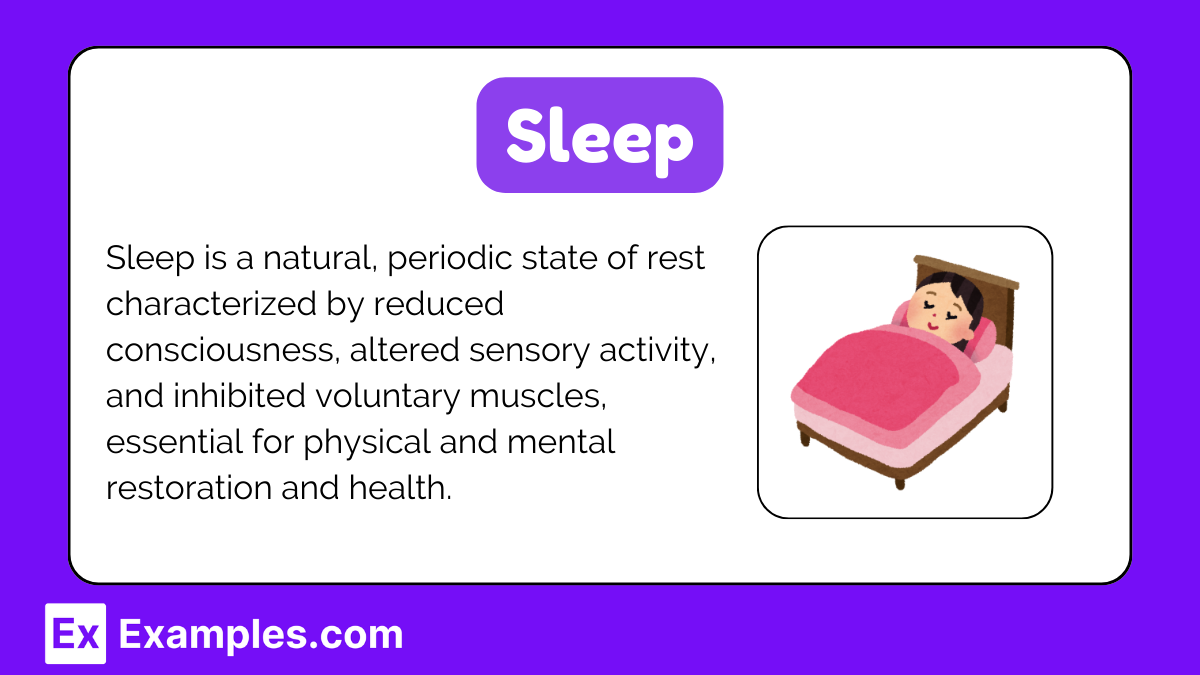
Sleep is a natural, recurring state of rest essential for physical and mental health. It involves reduced consciousness, decreased sensory activity, and inhibited voluntary muscles. Sleep cycles through stages, including REM and NREM, facilitating bodily restoration, memory consolidation, and emotional regulation.
Stages of Sleep
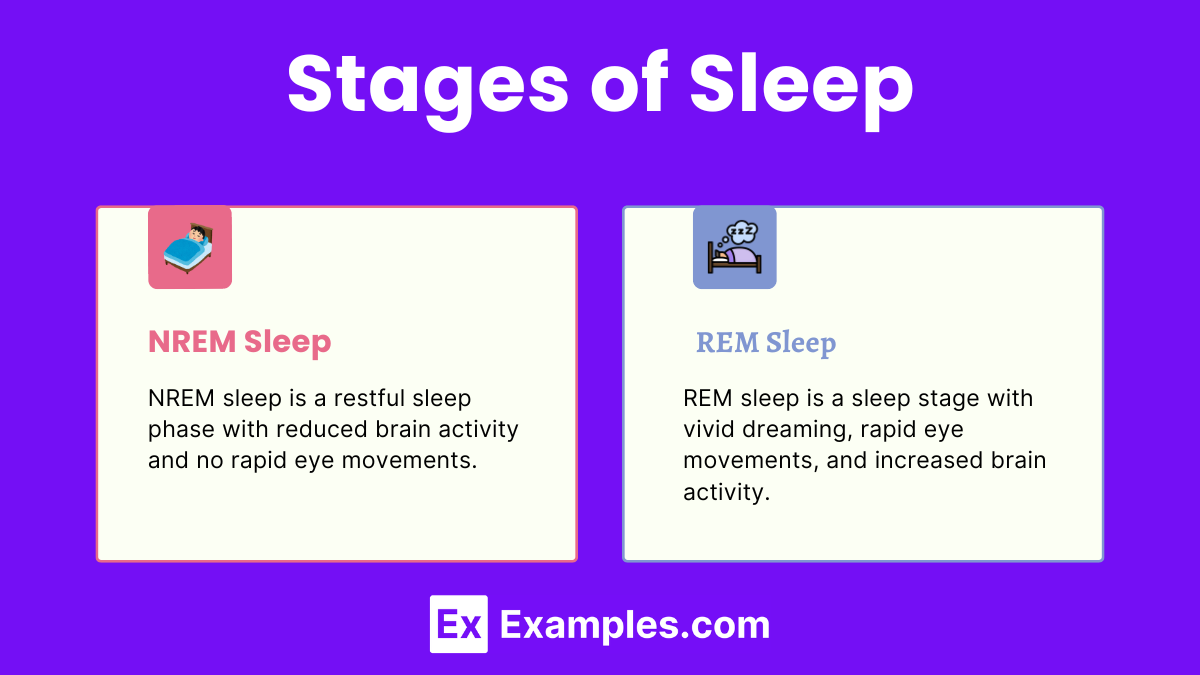
Sleep is divided into two main types: Non-Rapid Eye Movement (NREM) sleep and Rapid Eye Movement (REM) sleep. These types cycle throughout the night in stages.
NREM Sleep
NREM sleep is composed of three stages:
- Stage 1 (NREM1)
- Description: Transition from wakefulness to sleep.
- Characteristics: Light sleep, muscle activity slows, occasional muscle twitching.
- Brain Activity: Alpha and theta waves.
- Stage 2 (NREM2)
- Description: Onset of true sleep.
- Characteristics: Heart rate slows, body temperature drops, eye movement stops.
- Brain Activity: Sleep spindles and K-complexes.
- Stage 3 (NREM3)
- Description: Deep sleep or slow-wave sleep.
- Characteristics: Difficult to awaken, no eye movement, minimal muscle activity.
- Brain Activity: Delta waves.
REM Sleep
- Description: A unique stage where most dreaming occurs.
- Characteristics: Rapid eye movements, increased brain activity, temporary muscle paralysis.
- Brain Activity: Similar to wakefulness, with beta and theta waves.
Sleep Cycle
- Duration: A complete sleep cycle lasts about 90 minutes.
- Progression: Typically progresses from NREM stages 1-3 to REM sleep.
- Repeats: Multiple cycles occur throughout the night, with REM periods lengthening as the night progresses.
Functions of Sleep
- Restoration: Rejuvenates the body and brain.
- Memory Consolidation: Enhances learning and memory by processing information.
- Growth and Repair: Supports physical growth and repair processes, especially during deep sleep.
Dreaming
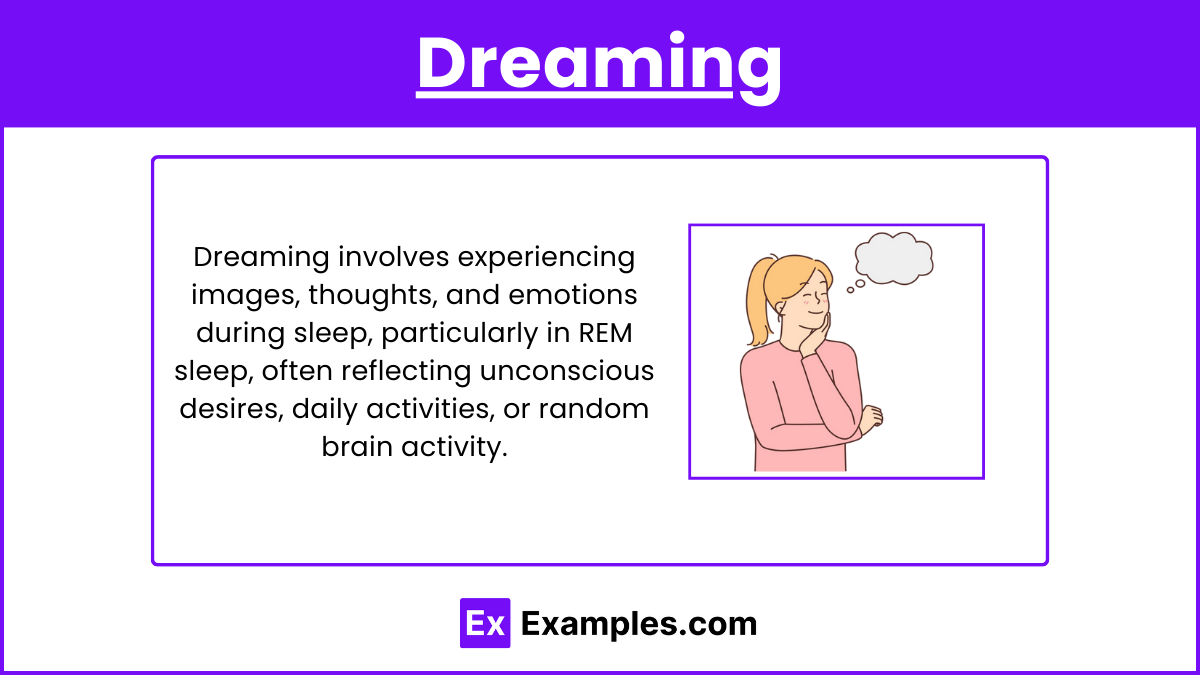
Dreaming is the experience of images, thoughts, and emotions during sleep, primarily occurring in REM sleep. Dreams can reflect unconscious desires, daily experiences, or random brain activity, serving functions like processing emotions, consolidating memories, and integrating new information with existing knowledge.
Nature of Dreams
Dreams are sequences of images, ideas, emotions, and sensations that usually occur involuntarily in the mind during REM sleep.
Theories of Dreaming
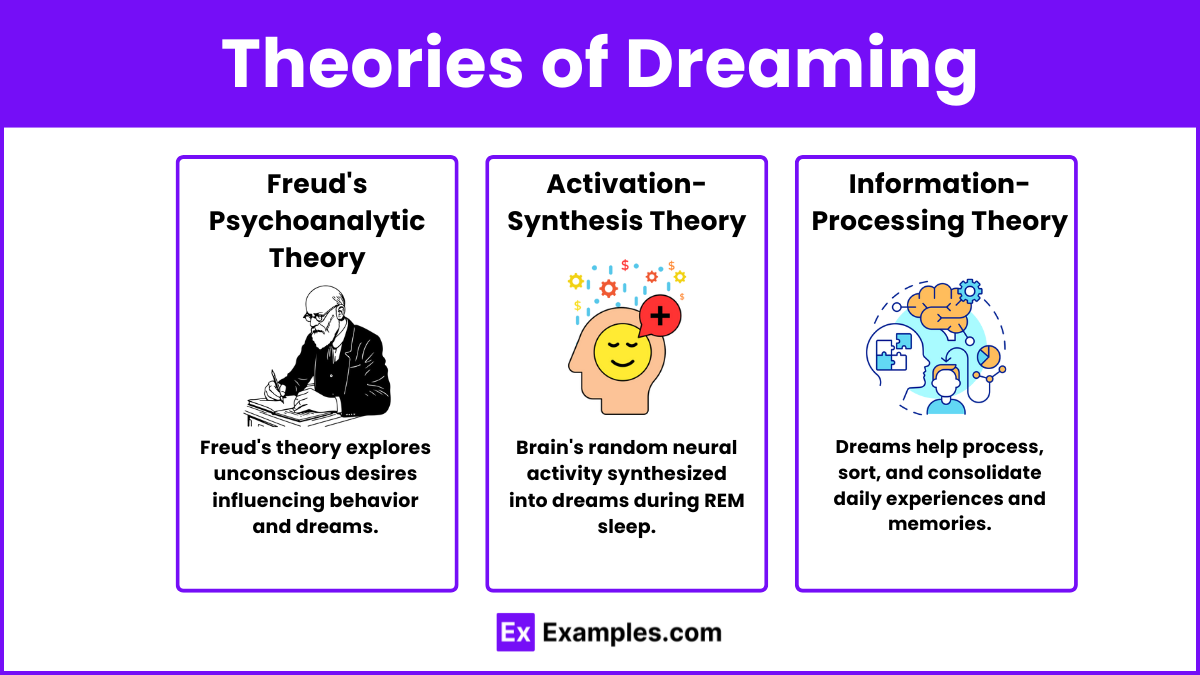
Freud’s Psychoanalytic Theory
- Concept: Dreams are a window to the unconscious mind, revealing hidden desires and conflicts.
- Components:
- Manifest Content: The actual storyline of the dream.
- Latent Content: The hidden psychological meaning.
Activation-Synthesis Theory
- Concept: Dreams result from the brain’s attempt to make sense of random neural activity during REM sleep.
- Mechanism: The cerebral cortex synthesizes signals from the brainstem into a coherent narrative.
Information-Processing Theory
- Concept: Dreams help process and organize information from the day, aiding memory and problem-solving.
- Function: Dreams sort through experiences and consolidate learning.
Common Dream Phenomena
- Lucid Dreaming: Awareness of dreaming, with the possibility of controlling the dream.
- Nightmares: Disturbing dreams causing fear or anxiety.
- Recurring Dreams: Repeated dreams with similar themes or scenarios.
Sleep Disorders
Common Sleep Disorders
- Insomnia: Difficulty falling or staying asleep.
- Sleep Apnea: Interrupted breathing during sleep.
- Narcolepsy: Sudden and uncontrollable sleep attacks.
- Sleepwalking: Performing activities while asleep.
- REM Sleep Behavior Disorder: Acting out dreams during REM sleep.
Impact on Health
Adequate sleep and healthy dreaming are crucial for maintaining overall health. Poor sleep quality and sleep disorders can lead to a range of physical and mental health issues.
Physical Health
- Obesity: Lack of sleep can disrupt hormones that regulate hunger, leading to weight gain.
- Diabetes: Insufficient sleep affects insulin sensitivity, increasing the risk of type 2 diabetes.
- Cardiovascular Disease: Chronic sleep deprivation is linked to hypertension, heart attacks, and strokes.
- Immune Function: Poor sleep weaknesess the immune system, making the body more susceptible to infections.
Mental Health
- Cognitive Function: Sleep is vital for cognitive processes such as memory consolidation, learning, and problem-solving. Sleep deprivation impairs these functions.
- Mood Disorders: Chronic sleep deprivation is associated with an increased risk of mood disorders like depression and anxiety.
- Stress: Lack of sleep elevates stress hormones, which can lead to chronic stress and affect overall well-being.
Sleep Disorders and Their Effects
- Insomnia: Causes fatigue, impaired concentration, and mood disturbances.
- Sleep Apnea: Leads to fragmented sleep and increased risk of cardiovascular issues.
- Narcolepsy: Affects daily functioning due to sudden sleep attacks.
- REM Sleep Behavior Disorder: Increases the risk of injury due to acting out dreams.

